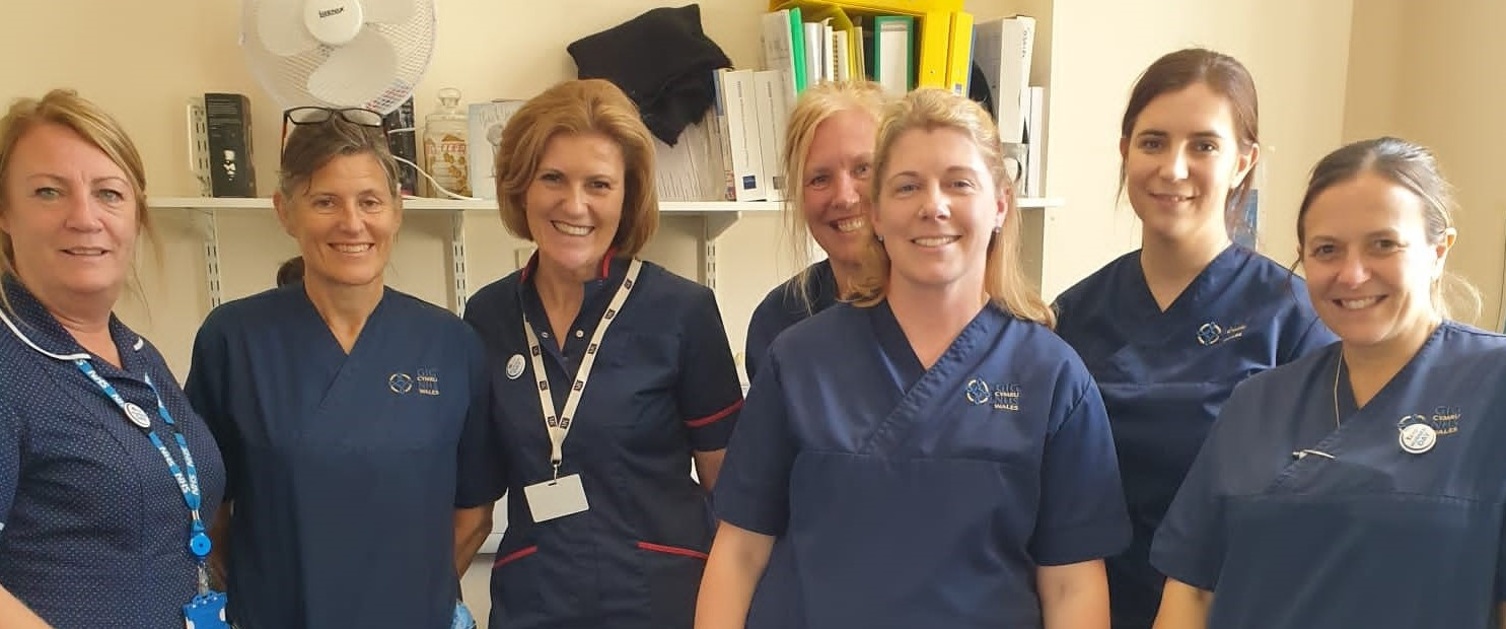Boost for district nurses will make it easier to receive care at home

Swansea Bay’s team of district nurses is set to expand, making it even easier for patients to be cared for at home.
From September, there will be significantly more district nurses working within the communities of Swansea and Neath Port Talbot.
An investment of £500,000 by the health board will see the workforce increase by 11.5 band five members of staff.
District nurses provide a healthcare service to people who are unable to visit the GP surgery or community clinics and who need nursing care, advice and support due to being permanently or temporarily housebound.
Pictured: Paula Heycock (left) with district nurses Philippa Sampson, Charlotte Greenslade, Rachel Gist and Nicola Jones, and team leader Kellie Jenkins.
The district nursing service works in partnership with colleagues in the community and hospitals to ensure the best care for patients.
Its aim is to enable people to maintain their independence and self-care where possible.
Having more district nurses means the service’s weekend and out-of-hours provision can expand, allowing more patients to be discharged from hospital sooner – or keep them out of hospital in the first place.
Paula Heycock, Head of Nursing for the health board’s Primary Community Therapies Group, said: “District nursing is a 24-hour, seven-day-a-week service.
“By increasing our workforce, we will be able to expand both our weekend and out-of-hours provision, bringing availability during these periods up to 80 per cent.
“Currently, we have a single point of access from Monday to Friday between 8am and 5pm but out-of-hours staff and patients go through to the switchboard to contact the service during weekend hours or out-of-hours periods.
“We will be able to offer a seven-day referral service with a triage nurse as a single point of access so it will be easier for staff to contact them to refer a patient.
“The triage nurse will be able to have conversations with staff who want to make a referral on a Saturday or Sunday too.
“It means staff will know how to refer patients to our service at all times, which will help to facilitate earlier hospital discharges and prevent hospital admissions.”
The district nursing team consists of specialist district nurses, community staff nurses and health care support workers with a wide range of skills.
By caring for patients at home, staff aim to prevent them going into hospital or needing to see a GP – which helps to ease the pressure on both healthcare settings.
In turn, it also helps to free up hospital beds for those who need them most.
District nurses oversee complex and end of life care in the community which can also allow patients to return from hospital sooner as their care can continue at home.
“It’s a wide ranging service and our staff have the knowledge and capability to offer very complex care in the community,” Paula added.
“We have good relationships with GPs and care homes and work with them so we can identify patients early, to prevent hospital admissions.
“We also have daily meetings with our colleagues in secondary care to identify patients we can help discharge from hospital.
“If they identify a patient who is coming to the end of their life, we can help with their discharge so they can be cared for at home instead.
“We can access necessary equipment, look at their medication and liaise with their families.
“We want to identify patients in need of care earlier so we can facilitate earlier discharges so they can return home to receive their ongoing care.”
The service has recently been reorganised so instead of having to travel across very wide areas, staff now cover a smaller area.
This means they get to see more patients a day.
Recruiting multiple nurses to support the ongoing expansion will help staff to respond to patients even quicker.
At present, district nurses carry out around 2,000 visits to patients every day.
Paula said: “Our recent organisational change has allowed staff to respond to patients in a more timely way.
“The increased capacity of our service is a long-term plan as we want to build more resilience into it.
“Aside from our investment, we will be looking at other ways we can create capacity within the team.
“In the future we want to look at creating more specialist roles which will help make a more robust, sustainable team able to meet the changing needs of our population.”
Rydym yn croesawu gohebiaeth a galwadau ffôn yn y Gymraeg neu'r Saesneg. Atebir gohebiaeth Gymraeg yn y Gymraeg, ac ni fydd hyn yn arwain at oedi. Mae’r dudalen hon ar gael yn Gymraeg drwy bwyso’r botwm ar y dde ar frig y dudalen.
We welcome correspondence and telephone calls in Welsh or English. Welsh language correspondence will be replied to in Welsh, and this will not lead to a delay. This page is available in Welsh by clicking ‘Cymraeg’ at the top right of this page.